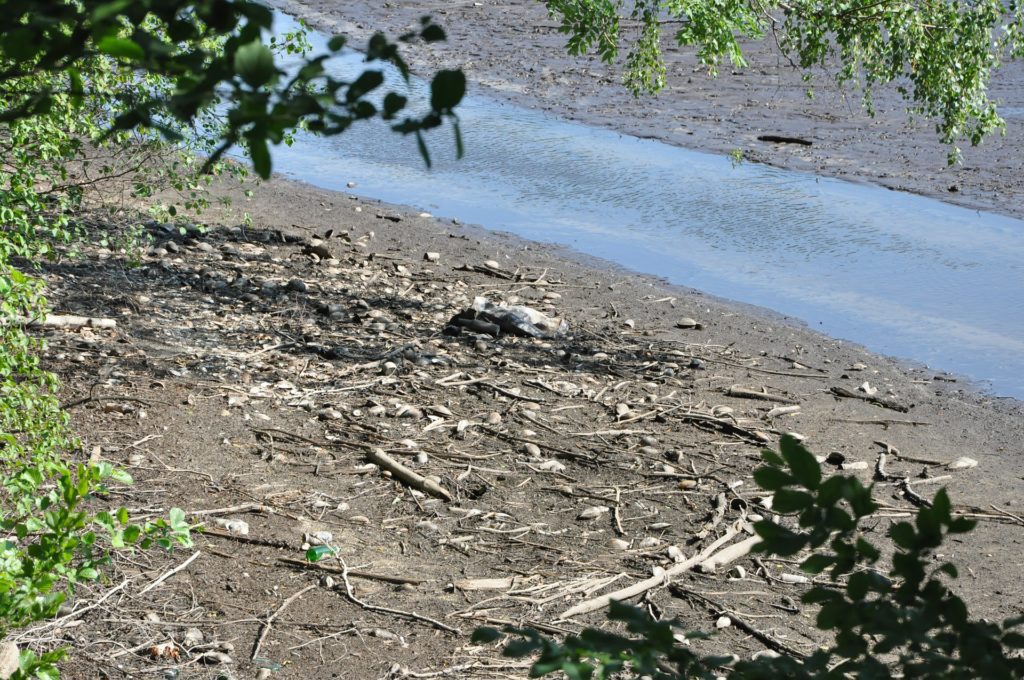The Impact of Drought on the Mystic Watershed
by Andy Hrycyna
People living in the Mystic River watershed have been relatively unaffected by the recent historic drought. Cities and towns have not demanded use restrictions, like bans on watering lawns, for instance.
But don’t let that fool you. The absence of mandates to conserve is an accident of where our towns’ water supply happens to originate. It does not mean that our area is immune to the drought.
First, some background.
An Historic Drought
2016 was the driest summer ever recorded in Boston, with 3.92 inches of rain in June, July, and August. The long-term average for that period is more than 10.5 inches.
The state declared a “drought warning” in the eastern two-thirds of the state. Only a “drought emergency”—which needs the governor’s declaration—results in stricter responses. Most municipalities in the drought area were urged to ban all outdoor water use, although local policies varied widely. A drought “warning” or drought “watch” remains in effect in March 2017, despite some relief from fall and winter precipitation.

When a streambed gets this low, it opens the door to all kinds of negative impacts. (Pixabay Stock photo.)
The cities and towns of the Mystic River watershed happen to get their water not locally, but mainly from the Quabbin and Wachusett Reservoirs in central Massachusetts through the system run by the Massachusetts Water Resources Authority (MWRA).
In 2016, the Quabbin reached levels considered “below normal” for the first time in 15 years, although its huge size means there is plenty of supply. The reservoir lost 10 billion gallons in August alone. But even if rain were to stop completely, the reservoir could still supply water for several years.
What happens in 2017 depends upon the level of precipitation we get this winter, spring, and early summer.
Thus no restrictions on water use have been imposed on MWRA-serviced municipalities throughout this period. What happens in 2017 depends upon the level of precipitation we get this winter, spring, and early summer.
Effects of Drought in the Watershed
But that’s not the whole story. The pipes carrying water from the center of the state to our faucets do not replenish our local ground and surface water. Those water resources have certainly been affected, with broad consequences.
Low Flow
The Mystic River and its major tributaries all experienced low flow conditions last summer. Some small streams, like Horn Pond Brook, which usually run freely, had dry stream beds.
When you see a river in dry weather, you are seeing the intersection of the water table with the surface. In dry weather, a river is being fed by underground water, and when it doesn’t rain, these flows can be reduced. In areas where people withdraw ground water on a large scale through wells, the level of rivers can be severely compromised in droughts. Sections of the nearby Ipswich River were dry in the summer, resulting in the deaths of thousands of fish, among other effects.
When flow is reduced, several other things change. Water temperature goes up and nutrients can become concentrated (or depleted depending on the circumstances). With low water levels, more light reaches areas that are normally dimly lit. Some plants love these conditions, including invasive plants, and we think the drought conditions contributed to the heavy growth of invasive milfoil in the Mystic.
Cyanobacteria
Nutrients, low flow, high temperatures, and sun are also a perfect recipe for blooms of cyanobacteria—blue-green algae that can produce toxins that endanger public health. The Mystic River Watershed Association (MyRWA) detected cyanobacteria last summer in the Mystic basin, and reported it to the Department of Public Health (DPH). Based on further testing, DPH issued health advisories in August—now lifted—urging people to avoid contact with the green water of the Mystic for more than two weeks. Experts tell us that the drought almost certainly contributed to this bloom.
Wildlife and Ecosystems
The drought also affects the ecosystems that surround our rivers, streams, and lakes. Insect populations can crash, with widespread effects. The reproductive success of land birds, which relies on insects, can be reduced. Some insect populations can increase: gypsy moths had a banner year, devastating trees, because the fungus that usually controls their population was inhibited. Warm water and low oxygen levels can stress fish. Fish passage can be blocked. Plants produce less nectar, and butterflies die. Avian botulism, which thrives in drought, kills ducks.
. . . 2016 was the hottest year yet on record (surpassing 2014 and 2015, the previous hottest years . . .
The Climate Context
The fact that 2016 was the hottest year yet on record (surpassing 2014 and 2015, the previous hottest years) is probably not unrelated to this year’s drought. Whether the reality of climate change means a dramatically higher frequency of droughts in the Mystic watershed in the future is not clear.
We can only hope for more rain in 2017.
Andy Hrycyna is a watershed scientist with the Mystic River Watershed Association.


Sorry, the comment form is closed at this time.